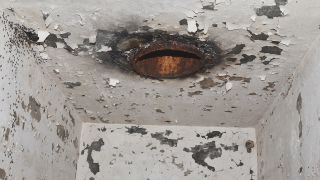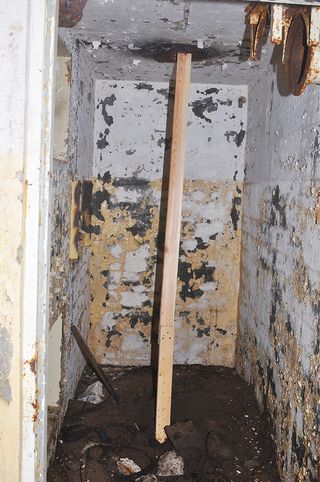It's an ant-eat-ant world.
.

Scientists found nearly a million wood ants trapped in a bunker formerly used by the Soviets to store nuclear weapons.
(Image: © Wojciech Stephan)
In
an abandoned nuclear bunker in western Poland, hundreds of thousands of worker ants that fell inside and were cut off from the main colony survived for years by eating the bodies of their dead.
When researchers visited the bunker in 2016, they described a community of nearly a million worker ants of the species Formica polyctena, or wood ants. The main colony teemed above ground on a mound atop the bunker's ventilation pipe; over the years, a steady stream of unlucky ants fell through the pipe and into the bunker. Since the pipe opened into the chamber from the ceiling, once the ants landed on the floor, they couldn't climb back out.
There was nothing for the ants to eat in the pitch-dark bunker; in 2016, the scientists hypothesized that the insects survived by cannibalizing their dead comrades. Recently, the researchers returned to the bunker to continue their investigation of the trapped ants, looking for evidence that the insects were eating the corpses of their nestmates.
The bunker, once part of a nuclear base, is near the German border and was used by the Soviet military to store
nuclear weapons from the late 1960s until 1992,
the researchers reported in 2016.
"During an inspection made in July 2015, we estimated the size of the bunker 'population' of Formica polyctena to be at least several hundred thousand workers, perhaps close to a million," the scientists wrote online Nov. 4 in the
Journal of Hymenoptera Research. While thousands of ants skittered over the bunker floor and walls, they were unable to walk on the ceiling where the pipe opening offered the only exit from their stone prison.

Ants could climb the bunker's walls, but couldn't walk across the ceiling to reach the chamber's only exit.
There were no ant cocoons, larvae or queens in the bunker, so the queenless "colony" wasn't breeding. Rather, it continued to grow because ants continually fell through the open pipe whenever
the main colony was active, the researchers reported.
Worker ants would not typically branch off and form a new colony without a queen, but the ants trapped in the bunker "had no choice," the scientists wrote. "They were merely surviving and continuing their social tasks on the conditions set by the extreme environment."
Eat or be eaten
For the new study, the scientists collected more than 150 dead ants from "cemeteries" — piles of bodies on the floor and near the walls around the bunker's main ant mound. Bodies with gnaw marks on their abdomens were thought to have been
cannibalized; sure enough, a "vast majority" — 93% — of the corpses showed signs of being eaten.
The ants' solution was a grim one, but cannibalism isn't uncommon in this species. Wood ants are known for waging "ant wars" —
fierce battles with other ant species that are typically fought in the early spring, when food is scarce, according to the study. As corpses of fallen soldiers pile up, workers drag the bodies into their nests to feed developing young. In fact, "nestmate corpses can serve as an important food source not only in periods of food shortage," the scientists wrote.
In the bunker, the corpses served as a never-ending buffet, enabling the ants to survive in a location where they would otherwise have starved, the researchers said.
Gruesome as those conditions were for the bunker ants, their story has a happy ending (at least, for the ants that weren't eaten). The study authors also wondered if they could help the trapped ants find their way home, and in 2016, they installed a vertical "boardwalk" — a wooden beam extending from the floor to the entrance of the pipe.

A wooden "boardwalk" led the trapped insects to safety.
When the scientists returned to the bunker in 2017, they found that most of the ants had taken advantage of the new escape route. The bunker area that was previously crawling with hundreds of thousands of ants was "almost deserted," presumably with all the wayward ants finally reunited
with their colony aboveground, according to the study.







Comments
Post a Comment